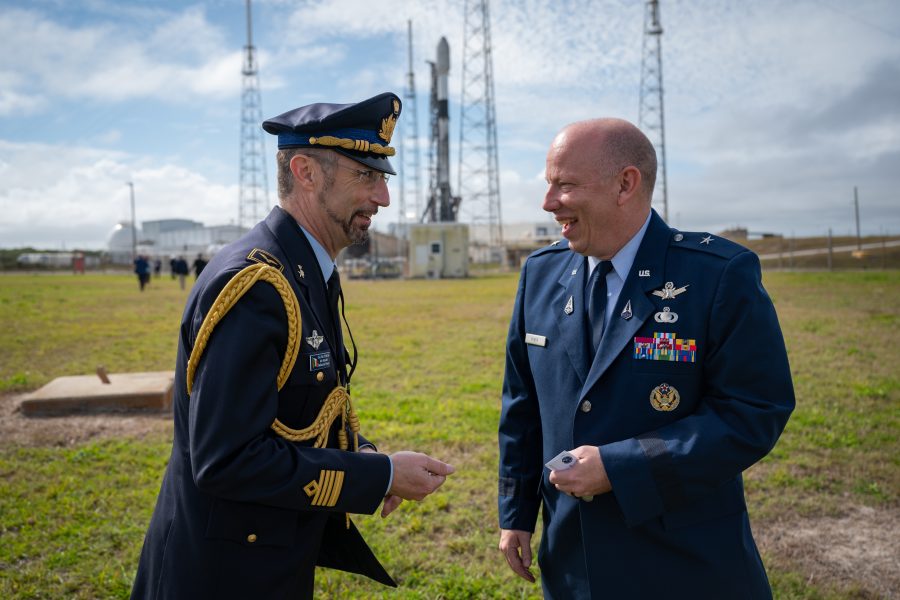Space Force leaders are advocating for reforms to the Pentagon’s foreign military sales process to better handle a surge in requests from international partners to buy U.S.-made military space systems.
The service has seen such requests from foreign militaries double since 2023—from around 40 to nearly 80 this year. Those cases encompass FMS cases as well as other Defense Department programs like Building Partner Capacity and Foreign Military Financing, both designed to support and facilitate international access to U.S. capabilities.
That growth is expected to continue, according to a Space Systems spokesperson, who told Air & Space Forces Magazine on Oct. 7 the service expects the dollar value of such cases to grow to between $10 and $12 billion over the next three to five years.
The Space Force attributes the spike in demand to a growing global recognition that space systems play a key role of play in economic and national security. Prior to 2021, the service’s FMS portfolio was limited to GPS user equipment. Now, the service is seeing international interest in a range of satellites and sensors and is actively looking to make more U.S. systems available to allies and partners.
Managing that demand, however, has been a challenge, according to USSF officials.
Maj. Gen. Stephen Purdy, the service’s acting acquisition executive, told reporters Sept. 23 that the Defense Department’s current FMS system is slowing the service down and, in some cases, causing allies to opt for commercially available, in-country systems rather than wait for U.S. cases to be approved and processed.
“I have to get an FMS system that works and that’s rapid,” Purdy said during a briefing at AFA’s Air, Space & Cyber Conference. “Our current system is not designed like that.”
In processing FMS cases, the Defense Department acts as an intermediary between a foreign government and a U.S. defense contractor. The Pentagon’s Defense Security Cooperation Agency, or DSCA, sets guidance for these and other international acquisitions.
The military services have been pushing for reforms to the FMS system for years, with officials arguing that the process is cumbersome and inefficient. DSCA has recommended changes to the system, including streamlining technology reviews, speeding up the approval process for non-program of record cases, and implementing new acquisition tools and contract mechanisms.
Those changes have yielded some improvements, but problems persist. Pentagon leaders, including Defense Secretary Pete Hegseth, have pledged to reduce “red tape” in the system. Hegseth hasn’t detailed his reform plan but told reporters in February that the department should apply “the most efficient and effective technology possible” to speed up the FMS process.
Purdy said he’s raised the Space Force’s concerns with the department, and “they’re looking at it actively.”
Meanwhile, Space Systems Command is working to make sure it has a trained and ready workforce to manage the increased case load. Commander Lt. Gen. Philip Garrant told reporters in a Sept. 23 briefing that he’s expecting the command to take on a “very large case” soon that will require more personnel.
An SSC spokesperson declined to provide details on the forthcoming deal, though they noted that it will be announced publicly. The spokesperson also would not confirm the size of the command’s current case management team or project how many more personnel it would need.
“We are working tirelessly, and accordingly, to ensure Program Executive Office and system deltas are adequately staffed to support this caseload and are working every day with our partners in [the Secretary of the Air Force International Affairs office] and DSCA to request and justify our requests for personnel funding,” the spokesperson said.
Beyond FMS, the Space Force wants its allies to have more insight into new programs and missions before they become formal programs.
Purdy said the service is “working with multiple countries on multiple mission areas,” including USSF’s data transport and moving target indicator architectures as well as a new effort called RG-XX—which will complement the service’s fleet of Geosynchronous Space Situational Awareness Program satellites with smaller, more maneuverable spacecraft.
“TBD on if those actually land, because obviously international countries are still thinking about how they want to balance their own industrial base and what they want to buy into on the American side,” Purdy said. “We’re trying to be open with all of them on our strategies.”


